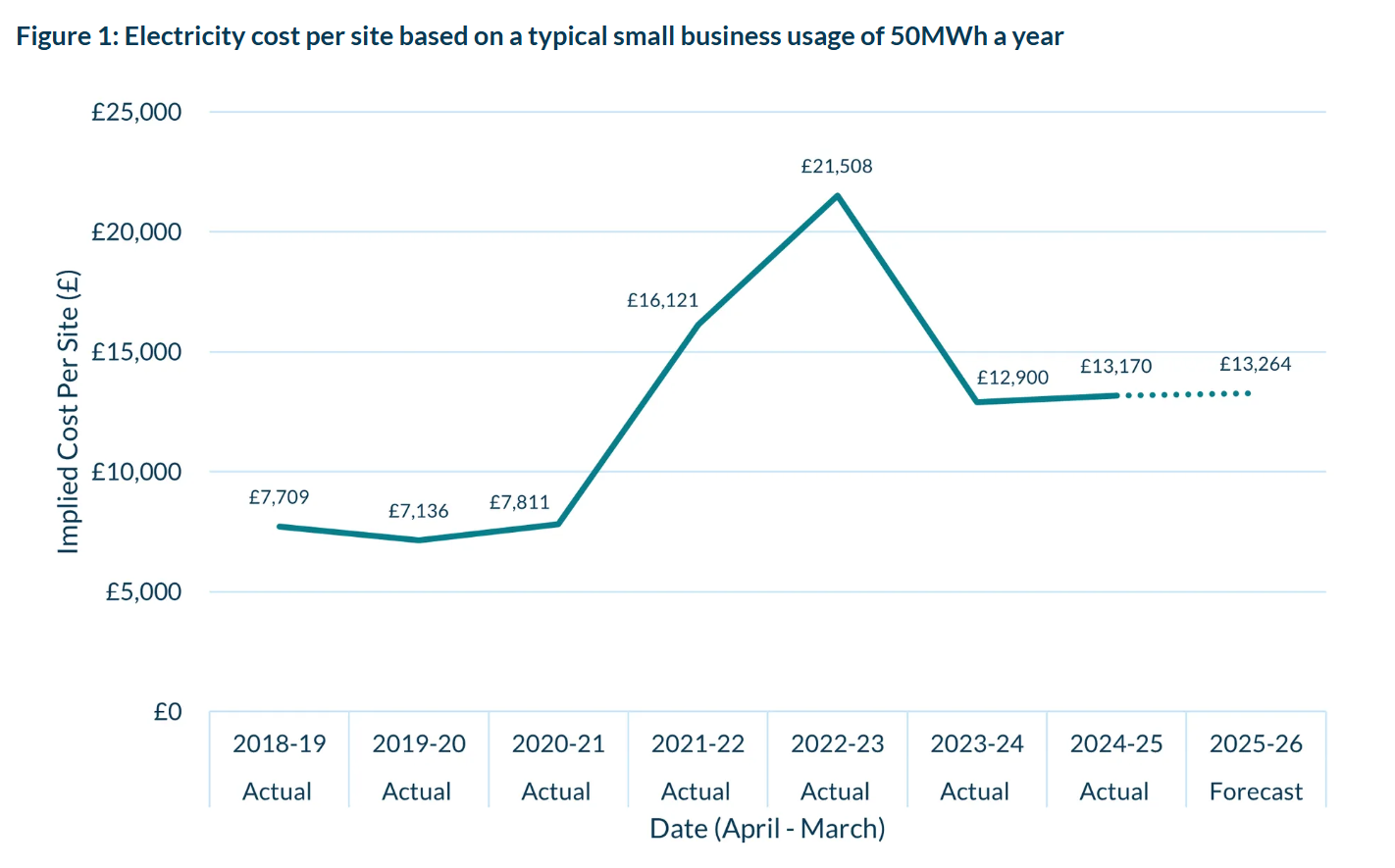How to secure predictable prices in a shifting energy market
The last thing you need, as a business owner, is an unexpected bill throwing your whole budget into chaos. Arm yourself with the knowledge you need to protect your business against the volatility of the energy market.

The last thing you need, as a business owner, is an unexpected bill throwing your whole budget into chaos.
Yet, every month, energy bills have become that one truly unpredictable question mark in your “Overheads” column.
(Sidenote here: just the other day our CCO shared a shocking £200 increase on his monthly household bill. So, there’s risk of a double whammy — household AND business bills.)
The minute you think you have a handle on it, Israeli-Iranian strikes hit the news…aaand the price of oil and gas. Then, Ofgem announces an infrastructure investment plan… aaand an increase to your standing charges.
You have a business to run. You don’t have time to spend monitoring energy market fluctuations. You shouldn’t need to be an expert, or to keep your eyes glued to the news, to get an idea of what your bill might be next month. We get it.
You can’t prepare for what you can’t predict. That’s what we aim to solve, here. This guide will help put the power back in your hands.
TL;DR: Fast track to predictable pricing
The problem: Energy prices are volatile, rising, and nearly impossible to plan for, creating a “reliability gap” between what businesses need and what the market delivers.
The cause: A broken system that ties electricity prices to global gas markets and layers on middlemen, markups and outdated rules.
The solution: Cut through the chaos with direct, transparent sourcing — like tem’s RED— to lock in predictable pricing you can actually plan around.
What we DO know about energy prices
Yes, month-to-month, your bill can feel unpredictable. But let’s look at the trends to figure out what we can anticipate, and what we might learn from pricing over the last few years.
Data from Cornwall Insight’s Business Energy Cost Forecast reveals that a typical small business such as a pub, restaurant or independent retailer is paying over £5,000 more a year in energy bills than prior to the 2021-22 energy crisis.
They predict bills will rise further in the April 2025 - March 2026 contract period. Of course, only time will tell. In our view, the prediction of “it’ll be more” seems likely, given the broader economics in the UK. If we had to put money on it (which we have), we think prices will continue to rise unless the energy sector undergoes major reform.

Source: Cornwall Insight
Unlike household energy bills, businesses do not benefit from a price cap to protect them from soaring bills. So, while there are some sectors that may benefit from government plans to reduce costs, the overall trend is clear. Expect bigger bills.
What does this tell us?
Costs are high, and (though lower than during the energy crisis) they’re staying that way.
Energy costs can fluctuate by a huge amount, sometimes more than doubling in a year.
The price of keeping the lights on is, sometimes, not worth the cost of doing business.
What ELSE do we know about the energy market?
So another thing we know is why the energy market is constantly shifting.
That’s no secret. Here’s how it works:
Global gas prices set the price for electricity
Studies show that gas still sets the cost of energy, no matter where you get it from. Across Europe, one study found fossil fuel- based power plants set electricity prices 58% of the time, while generating only 34% of electricity a year.
In 2024, the United Kingdom generated 66% of its electricity from low-carbon sources, significantly higher than the global average. Even though we are leading a number of nations in renewable generation, we can’t get those prices down. This is the reason why:
Price is determined by something called “marginal cost”, meaning the cost of producing the next unit of energy needed to meet demand, usually from the most expensive available source. Energy markets are designed to pay all suppliers the same market-clearing price. Ipso facto, everyone gets paid the gas rate. The system rewards the most expensive source of energy, not cheap, clean, renewables.
The price of supply is affected by geopolitical shocks
The UK imports about 66% of its gas, mostly piped in from Norway. Yes, Norway - not a country known for volatility. And yet, the geopolitical landscape absolutely impacts our energy prices.
Again, this is because UK electricity prices are still tethered to the global gas market.
When gas becomes expensive abroad due to heatwaves, cold snaps, or political unrest, those price spikes ripple through the UK energy system. Even stable suppliers like Norway can’t shield us from the volatility baked into the way prices are set.
The war in Ukraine made this painfully clear. Russian supply cuts triggered global bidding wars for liquified natural gas. That drove up prices everywhere, including here, even though we don’t buy Russian gas. The country has yet to recover, nearly five years on.
Policy shifts and reforms further impact the cost of energy
Governments are trying to fix the problem. The UK has introduced a number of reforms over the years, from time-of-use tariffs to Contracts for Difference (CfDs), designed to make prices fairer. There’s even a proposal called “Pot Zero” to bring older low-carbon generators into the CfD system, helping to break the link between gas prices and electricity bills.
The zonal pricing vs. Reformed National Pricing debate was recently decided in the summer REMA review. While we welcome not adding more complexity on top of a broken system, the public will be paying for grid updates, so another price hike there.
The market structure is not built to deliver fair pricing and stability
From what we’ve seen, government reforms are patches, not structural changes. They still operate within the same old framework. One designed for fossil fuels and centralised control.
The wholesale energy market is broken, funnelling profits into the pockets of the few, while driving up prices for the many. The irony of it is, our local renewable generators aren’t even benefitting either. It’s middlemen and markups that add up to 30% to your business’s bills, each and every month.
So, how do you make your energy prices more predictable?
Good news: if knowledge is power, then we’ve just put a lot of power back into your hands.
You’ve got a clear line of sight on just how and why the energy market is broken, and you can predict the bigger trends: that energy prices are expensive, and they will remain so unless we do something radical to fix the system.
Predictability matters more than ever
This matter because unpredictable energy prices ruin planning. They distort budgets, delay investment, and chip away at margins. As a business, when you know what your outgoings will be, you can plan ahead, make scheduling or hiring decisions, adjust pricing, re-evaluate your suppliers… unpredictable energy bills are a blocker on so much crucial decision-making.
So, don’t underestimate the power of predictable energy pricing. You first step to securing a better rate for your business is one of prioritisation. Put this at the top of your to-do list.
Don’t fall for false promises
Next. Traditional suppliers peg prices to the wholesale market no matter how “green” the label. Then there’s the illusion of certainty in certificate-based “100% renewable” deals, otherwise known as REGOs. Otherwise otherwise known as carbon offsetting.
You need to look elsewhere. The only predictable thing about standard utilities is that they’re all drawing from the same poisoned well.
Get power, direct
Real predictability comes from direct sourcing. When you know your energy comes from a named generator, with a clear cost and no middlemen, you’re not guessing, you’re in control.
Now yes, if you have the means to do so, you could invest in on-site generation, too. But we reckon the vast majority of businesses don’t want to get into the energy business, they just want to buy power, at a reasonable, stable rate of exchange. No fuss, no bureaucratic nightmares (PPAs), no spiel.
That’s where we come in.
Close “the reliability gap”
You can’t stop the market from shifting, but you can choose a model built for stability. tem helps you plan with clarity, not just hope.
Close the reliability gap with transparent sourcing, pricing, billing. You name it, we’re an open book.
Built using our proprietary pricing engine, we are bringing the fintech revolution to energy, finally delivering energy prices you can rely on, at rates you can actually afford.
Plan ahead: get RED™
Signing up for tem’s utility offering, RED™, is the next best decision you’ve every made. Start your journey, today.
